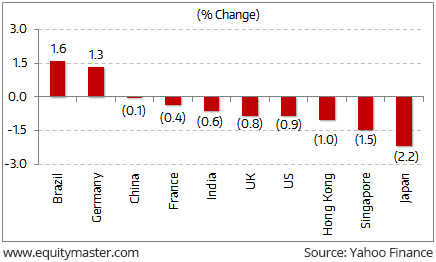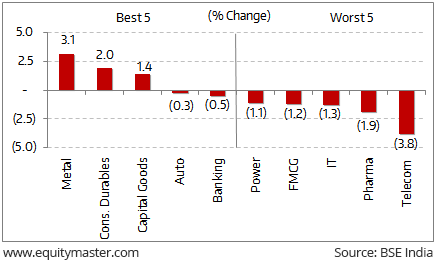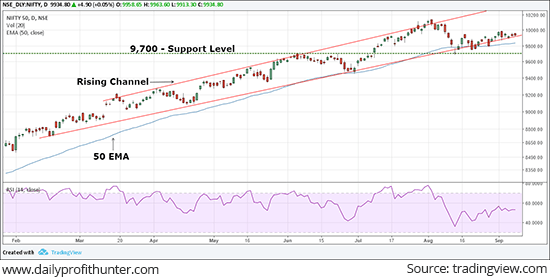- Home
- Todays Market
- Indian Stock Market News September 9, 2017
Geo-Political Concerns Drag Down Global Markets Sat, 9 Sep RoundUp
Geo-political tensions escalated during the week as North Korea conducted its sixth and most powerful nuclear bomb test. Serious tensions seem to be brewing up between US and North Korea.
A full-blown war between the two countries would not bode down well for the financial markets. This is exactly why the financial markets reacted negatively during the week and flocked to safe havens such as gold. The prices of gold surged by 1.3% during the week.
Further, the US is two weeks away from the Federal Reverse's next policy meeting and it is highly likely that it will hold the rates given the recent economic data.
The Fed conducted a survey on the US economy that suggested the economy expanded at a modest to moderate pace from July to mid-August. Inflation too remains a major concern. A rate hike in this scenario may not bode well for the US economy.
Asian markets too were under pressure during the week. Benchmark indices in Japan and Singapore fell by 2.2% and 1.5% during the week. Indices in Japan fell as the yen strengthened against dollar. Japan being a net exporting country, a rise in the value of yen is bad news for many Japanese companies. This led to the correction in the index.
Back home, the S&P BSE Sensex fell marginally by 0.6% during the week. Manufacturing PMI rose to 51.2 in August, from 47.9 in July. The PMI is the reading of the country's manufacturing and service sector output and is updated monthly. A reading above 50 indicates expansion, while any score below this mark denotes contraction. Going forward, manufacturing activity is expected to grow as manufacturers begin production for the festive season.
Key World Markets During the Week

Stocks in the metal (+3.1%) space were the biggest gainers for the week. While stocks in the Telecom (-3.81%) and Healthcare (-1.92%) sectors were the biggest losers.
BSE Indices During the Week

Now let us discuss some key economic and industry developments during the week gone by
In news from the automobile sector, proposal has been made to raise the cess levied on luxury, sports utility and large cars under the Goods and Services Tax (GST) regime to 25% from 15% earlier.
Automobile manufacturers may face some hiccups on the back of this development. Also, executives from auto industry say they may re-evaluate their business plans owing to the above development. Meanwhile, we'll keep you posted on the recent developments from this space.
Speaking of automobile sector, there's a change of preference seen for first time car buyers in India. As per the data, the new generation of first-time buyers is moving up the ladder to premium cars.
First-time car buyers accounted for 31% of Swift sales in FY14. That number jumped to 52% in the June quarter of FY18.
The above trend is similar to what has happened in other consumer segments such as mobile phones and consumer electronics. It indicates a shift towards premiumization in India's car market. As we wrote in a recent edition of The 5 Minute WrapUp...
- The growing preference for these feature-rich and costlier models as first cars indicates growing premiumization in India's car market. This trend indicates that first-time buyers are getting more aspirational. Interestingly, the age profile of first-time car buyers and higher disposable income are contributing to this phenomenon.
If this trend continues, going forward, one would see compact SUVs becoming the preferred choice for first-time buyers. The trend is already under way. The percentage of such buyers for Brezza for instance stood at 37% in the first quarter of FY18.
With the above shift, premiumization will be an important growth driver for the auto industry in coming years.
The finance ministry has given its nod to four Foreign Direct Investment (FDI) proposals, worth Rs 5 billion in the previous two months.
Inflow of FDI into India increased by 9% to record level of US$43.48 billion in 2016-17 on account of reform measures undertaken by the government.
Notably, Foreign Direct Investments (FDI) plays an important role in the economic development of a country. It is a source of long term capital that helps build critical infrastructures in the economy.
Since 2014, the Modi led government has laid a great emphasis on welcoming global best practices to be employed in India.
The government began this with the launch of 'Make in India' initiative in September 2014. Further, the government has carried out FDI reforms in sectors like rail infrastructure, defence and in financial sector, medical devices and construction sectors etc.
In addition, initiatives such as introduction of composite caps in the FDI policy and raising the FIPB approval limit were also undertaken to promote ease of doing business in the country.
Movers and Shakers During the Week
| Company | 01-Sep-17 | 09-Sep-17 | Change | 52-wk High/Low |
|---|---|---|---|---|
| Top Gainers During the Week (BSE Group A) | ||||
| Future Enterprises | 46 | 56 | 18.8% | 62/14 |
| Jaiprakash Power | 5.9 | 7.2 | 14.4% | 9/4 |
| Gitanjali Gems | 61 | 74 | 13.9% | 94/46 |
| Lanco Infratech | 0.8 | 0.9 | 18.2% | 5/1 |
| 63 Moons Tech | 63 | 73 | 15.7% | 93/54 |
| Top Losers During the Week (BSE Group A) | ||||
| Reliance Capital | 857.55 | 762.70 | -11.1% | 878/408 |
| Idea Cellular | 88.9 | 79.75 | -10.3% | 124/66 |
| Dish TV | 81 | 76 | -6.9% | 111/70 |
| Adani Enterprise | 136 | 128 | -6.4% | 161/58 |
| Indian Bank | 291 | 272 | -6.4% | 365/190 |
Some of the key corporate developments in the week gone by
Infosys promoters, N.R. Narayana Murthy and Nandan Nilekani, have offered to sell as many as 1.77 crore shares in the company's buyback offer.
As per Prime Database, in the first five months of FY18, at least twenty companies have offered to buy back shares worth Rs 480 billion.
As per Rahul Shah, co-head of Research, investors should not assume buybacks are always good. Here's an excerpt of what he wrote in a recent edition of The 5 Minute Wrapup:
- The reason behind the buyback must be investigated. At the end of the day, an increase in earnings should be more a function of the inherent robustness of the business, as that's what will help it continue to grow at a healthy pace.
The topic also brings us to ask: Do buy-backs offer an arbitrage opportunity for retail investors? Ankit Shah has answered this question in a recent edition of Equitymaster Insider. You can access the issue here.
Eicher Motors, is set to make a binding offer to acquire the iconic Italian superbikes Ducati for $1.8-2 billion.
The report adds that the acquisition, if successful will help Eicher expand its portfolio, increase its brand equity and global presence, in addition to giving it access to Ducati's technology.
Eicher Motors is believed to be the frontrunner in the ongoing auction for the Ducati disposal and is currently finalizing the financing and structural terms of the merger with a consortium of global banks.
The Volkswagen group, which owns Ducati through its Audi arm has been trying to sell its Ducati business since early April this year. The divestment plans had reportedly triggered interests from a diverse set of potential suitors, including Harley Davidson, Suzuki home grown Bajaj Auto and Hero MotoCorp as well as private equity buyout funds like KKR and CVC Capital Partners.
However, as of now Eicher Motors remains one of the frontrunners.
According to a leading financial daily, L&T plans to set up an InvIT (infrastructure investments trust) through its infrastructure arm- L&T IDPL.
The engineering conglomerate said that an application for registration of the InvIT as an infrastructure investment trust was filed by L&T IDPL with the stock market regulator.
InvITs are debt instruments that facilitate capital into the infrastructure sector by pooling small sums of money from investors to help infrastructure developers to monetise infrastructure assets.
The listing of instruments enables promoters of infrastructure to monetise completed assets and raise funds for other long-term projects.
Just Released: Multibagger Stocks Guide
(2017 Edition)
In this report, we reveal four proven strategies to picking multibagger stocks.
Well over a million copies of this report have already been claimed over the years.
Go ahead, grab your copy today. It's Free.

Listing of few of its completed infrastructure projects would enable the company to free cash stuck in those projects and would enable it to put the same in more profitable ventures.
Earlier this week, drug maker Lupin had announced the launch of its drug named Olmesartan Medoxomil- a hypertension drug, in the US market.
The company has launched this drug in strengths of 5 mg, 20 mg and 40 mg after having received an approval from the US Food and Drug Administration (USFDA).
Talking about approvals, Ajanta Pharma too received final ANDA (abbreviated new drug application) approval from the US Food and Drug Administration (USFDA) for Entacapone Tablets. This new approval is part of a portfolio of products that the company has developed for the US market.
The tablets are a bioequivalent generic version of Comtan 1 Tablets and are used for the treatment of Parkinson's disease.
The Indian pharmaceutical industry has come under a lot of regulatory pressure in the past few years. The list of pharma sector woes is long. So, is there light at the end of the tunnel? Girish Shetty, our research analyst thinks there is.
As per him, it doesn't make sense to paint all pharma stocks with the same brush. The leaders of the industry will certainly survive this phase. There are interesting, niche pharma stocks that are worth your attention.
Facing pricing pressures in the domestic and export markets, currency fluctuations, as well as manufacturing issues related to their plant, there is a transformation happening in the overall sector as to how business is done and will be done in the future.
Finally, ex-governor Mr Rajan broke his silence about notebandi and shared his views in his new book, I Do What I Do. Mr Rajan warned the government back then that the short-term economic costs of notebandi could outweigh the long-term benefits. He also suggested there were better alternatives to curbing black money.
And it seems he was right. The aim of notebandi, we were told, was to curb black money. Government officials said they believed there was a lot of black money in circulation that wouldn't come back to the banks after the 'exercise'. This process of eliminating certain monetary paper notes would supposedly destroy black money.
However, the fact is 99% of the demonetised notes have been deposited back in the bank. This suggests major flaws in the demonetisation framework from the beginning.
Worse, the whole exercise seems to have put severe pressure on economic growth. Vivek Kaul has developed an Indian 'Economic Thermometer' to track the financial health of various sectors. The current reading does not suggest the economy is heading in a positive direction. From April to June 2017, fifteen of the 21 indicators have lost steam, compared to the same period last year.
Please read Vivek's latest letter on India's Economic Slowdown to know more about the financial health of our economy across various sectors.
Ajit Dayal too has weighed in on the notebandi issue and has termed it as a dumb idea. He has clearly articulated his views and has written an unbiased piece in The Honest Truth. You can read it here.
In time like these, we suggest investors to allocate 5-10% of their portfolios to gold. We see gold as an excellent inflation hedge as well as a hedge towards any political or economic uncertainty. If your allocation isn't quite there yet, there may be no better time than now to add a little 'insurance' to your portfolio.
And here's an update from our friends at Daily Profit Hunter...
The Nifty 50 Index traded on a negative note during the week. On Monday, it opened gap up but slipped sharply over 100 points taking cues from global markets. It recovered a bit on the next day but the selling continued going into midweek. On Thursday, it again recovered some of its losses. Finally, the index traded on flattish note on the final day of the week to end the weekly session 0.39% down.
The index is finding support from the channel's support line. If it breaks below the channel's support line it might open up lower level for the index. In that case, 9,700-9,800 is the level to watch. This is the strong support zone for the index as mentioned in our August rollover report. You can read the detailed market update here...
Nifty 50 Index Traded on a Negative Note

For information on how to pick stocks that have the potential to deliver big returns, download our special report now!
Read the latest Market Commentary


Equitymaster requests your view! Post a comment on "Geo-Political Concerns Drag Down Global Markets". Click here!
Comments are moderated by Equitymaster, in accordance with the Terms of Use, and may not appear
on this article until they have been reviewed and deemed appropriate for posting.
In the meantime, you may want to share this article with your friends!